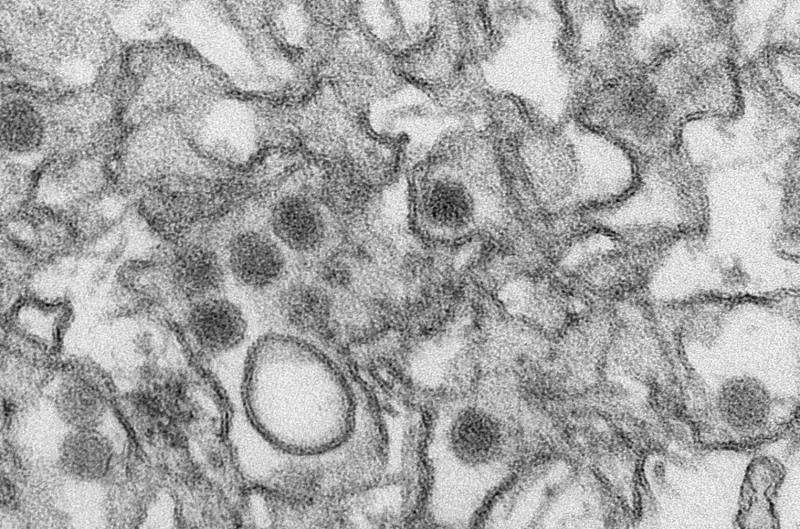This article has been reviewed according to Science X's editorial process and policies. Editors have highlighted the following attributes while ensuring the content's credibility:
fact-checked
trusted source
proofread
Researchers find Zika virus is effective when used to treat a type of childhood cancer in mice

Injecting neuroblastoma tumors with Zika virus shrank or eliminated those tumors in studies with mice, suggesting that the virus could someday serve as an effective cancer therapy, according to a study led by Nemours Children's Health researchers and published in Cancer Research Communications.
Neuroblastoma is a rare childhood cancer that typically develops in the sympathetic nervous system or the adrenal glands. Only 700 to 800 cases are diagnosed each year in the United States, accounting for 6% of childhood cancer diagnoses. However, high-risk neuroblastoma takes a disproportionate toll, causing 15% of childhood cancer deaths.
"More than half of patients with high-risk neuroblastoma do not respond to chemotherapy or radiation, or they respond initially, but develop a recurrence," explained the study's senior author, pediatric surgeon Tamarah Westmoreland, MD, Ph.D., Associate Professor of Surgery at Nemours Children's in Orlando. "These patients are in urgent need of new treatment options."
In recent years, researchers have discovered that Zika virus, which is carried by mosquitoes, can potentially be used to kill cancer cells. Zika virus infections in pregnant women can cause serious birth defects as the virus targets CD24, a developmental protein.
Previous research has suggested that certain cancers that express the CD24 protein are also vulnerable to the Zika virus, opening the door for Zika virus to be used as a treatment. In this study, Westmoreland and first author Joseph Mazar, Ph.D., Research Scientist at Nemours Children's, examined Zika's potential against neuroblastoma.
The researchers studied mice with neuroblastoma tumors that express high levels of CD24. They injected half of the mice with a saline solution, and the other half with Zika virus. Tumor sizes were monitored three times a week thereafter.
The study showed that all mice injected with the Zika virus experienced a nearly total loss of tumor size. The highest dosage tested resulted in complete elimination of the tumor, which was confirmed by an independent Nemours Children's pathologist. In four weeks of follow-up, there was no recurrence of the tumor. Furthermore, the mice did not develop any symptoms of Zika virus infection or any side effects.
To determine whether treatment with Zika virus is likely to help human patients survive longer, the researchers developed mouse models of human neuroblastoma tumors, treating them with either Zika virus or a saline solution.
Twenty-eight days after the treatment, all tumors that received the saline solution had grown by as much as 800%. The tumor models that had received Zika had shrunk to approximately 12% of the original mass, which was confirmed to represent scar tissue rather than the tumor cells. After four additional weeks, no further tumor growth was detected, suggesting that patients treated with Zika virus would be more likely to survive.
The researchers cautioned that the use of Zika virus as a cancer therapy will require extensive additional studies encompassing safety and efficacy. They are currently testing Zika virus treatment in mouse adrenal glands growing neuroblastoma, mimicking neuroblastoma's most typical location in humans. Routine use in the United States would require testing in clinical trials and ultimately approval by the U.S. Food and Drug Administration.
"With further validation, Zika virus could be an extremely effective bridge therapy for patients with high-risk neuroblastoma," said Mazar. "We also see potential for Zika virus to be used to treat children and adults with other cancers that express high levels of CD24."
"Neuroblastoma is often a very challenging diagnosis, especially for the patients who are unlikely to respond well to chemotherapy," said Matthew M. Davis, MD, MAPP, Executive Vice-President, Enterprise Physician-in-Chief and Chief Scientific Officer of Nemours. "Dr. Westmoreland and Dr. Mazar are at the forefront of potentially lifesaving cancer treatment. We are hopeful that this study will pave the way toward improved survival for patients with neuroblastoma."
Zika background
- Zika virus was first identified in monkeys in Uganda in 1947, and first identified in humans in 1952. Spread by the bite of an infected mosquito, Zika virus can be passed from a pregnant woman to her fetus as the virus targets CD24, a developmental protein. Infection during pregnancy can lead to birth defects, including a small head size and an underdeveloped brain.
- While Zika virus infection is most common in tropical regions, the United States experienced a rise in cases in 2016 and 2017, primarily in Florida and Texas.
- In most humans, Zika virus infection results in mild cold-like symptoms. Most people infected with the virus never develop symptoms.
- This study builds upon a 2018 study by Westmoreland, Mazar, and Kenneth Alexander, MD, Ph.D., Chief of the Division of Infectious Diseases at Nemours Children's Health in Orlando. That research established the precedent that Zika virus could kill neuroblastoma cells.
- Zika virus has also been studied as a potential treatment for glioblastoma, a deadly brain cancer.
More information: Joseph Mazar et al, Cancer Research Communications (2024).



















